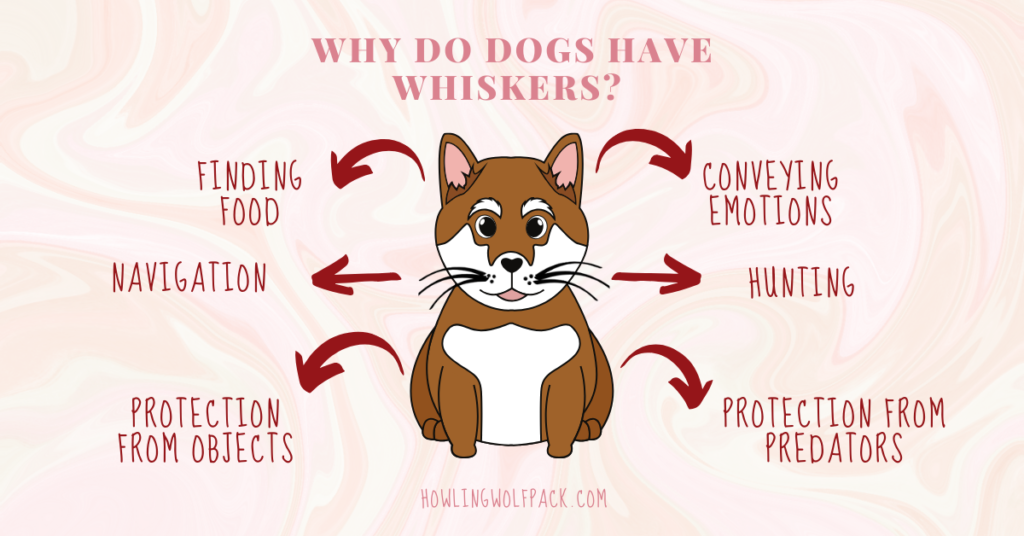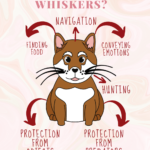Have you ever wondered how your dog can run through thick brush and not poke themselves in the eye with the many branches and leaves? You know if you were running through the same trail you would for sure poke your eye out. Well, that’s because dogs have whiskers and we don’t!
These incredibly cute protruding hairs are not just to make our dogs look adorable, they have a very important function in helping your dog navigate the world around them!

What Are Dog Whiskers?
Dog whiskers are long and coarse hairs strategically located above a dog’s eyes, on a dog’s muzzle, cheeks, and along a dog’s chin. They are much thicker and stiffer than ordinary hairs and are connected to nerve endings in the hair follicles which send sensory messages to the dog’s brain.
Also known as vibrissae, dog whiskers are not like other hairs in a dog’s fur as they are much more sensitive to touch and play a key role in their sensory perception much like our fingertips or eyes do for us. All dogs have these tactile hairs, including newborn pups and hairless breeds.
Types of dog whiskers
- Mystacial – muzzle whiskers (located on your dog’s upper lip and muzzle) are also called mystacial whiskers which is derived from the ancient Greek word for mustache!
- Genal – A dog’s cheek whiskers are also known as genal whiskers.
- Supraorbital – the whiskers situated just above your dog’s eyes
- Interramal tufts – the interramal whiskers are found below the chin that help your dog sense what’s below their face.
5 reasons why dogs have whiskers
1. Navigation
Whiskers are sensitive to pressure and changes in air currents, which is helpful when dogs navigate dark areas at night like woods and trails outside or tables and chairs inside. As the air bounces off the nearby surfaces the dog’s whiskers can detect subtle changes in the air and knows to avoid the obstacles in their way.
2. Protection
Dog’s whiskers play a role in protecting a dog in many ways:
Protection from objects
Dog whiskers can help protect a dog from injury. They allow them to sense if an object is near before coming into contact with it – like a “sixth sense”. Dogs can estimate the size, shape and speed of objects by sensing the air currents which bump off the object and come back to the whiskers. When the air currents hit the whiskers sensory messages are sent to the dog’s brain allowing them to avoid the object and avoid an injury.
The whiskers above the eyes help protect the eyes from dirt falling in them, much like our eyelashes, as they will blink when those whiskers are touched. They also allow dogs to run through thick brush without poking their eye out as the whiskers can sense where the branches are, allowing them to avoid them.
Protection from predators
Whiskers are sensitive to very faint vibrations, which can alert dogs to potential predators. When something comes closer to their face, the air pressure around them will change allowing them to sense the predator’s presence.
3. Conveying emotions
Whiskers can be an indication of a dog’s mood and are a good communication tool to other dogs. If a dog’s whiskers are laid back, this often means they are relaxed, whereas if they are standing straight out, this could be an indication that a dog feels threatened or anxious.
4. Hunting
When a dog is hunting, their whiskers can detect the slightest movements of prey in the surrounding area, helping the dog to hone in on its target. The whiskers also provide the dog with sensory and tactile information as it runs quickly through dense brush or narrow spaces, helping it to detect obstacles and other potential hazards. This ability has been especially helpful for hunting dog breeds like Beagles and Terriers as their whiskers serve as prey detectors underground or hidden in tight spaces.
5. To find food
Dog whiskers help dogs find food by acting as sensory receptors. Whiskers are highly sensitive to tactile stimulation, which helps dogs sense changes in air pressure. This allows them to detect objects in the dark and to identify food sources by detecting the vibrations they give off. This heightened sense of touch helps them find food in the environment.
Can dogs feel pain in their whiskers?
Yes, dog whiskers have pain receptors so dogs can feel pain in them. Whiskers are highly sensitive to vibrations, air movements and touch and can cause pain if they are pulled or tugged. They are also sensitive to extreme heat and cold as well as chemicals, so it is important to be gentle when handling your dog’s whiskers.
Do dog whiskers grow back?
Yes, whiskers are just like regular hair from hair follicles and typically grow back when they are plucked or trimmed. The growth rate of the whiskers depends on many factors, such as the breed and age of the dog. However, it usually takes about three to four weeks for them to regrow.
Is it not recommended to trim or pluck a dog’s whiskers though as this can seriously inhibit their movement and ability to protect themselves. Removing a dog’s whiskers for esthetic reasons is even banned in some places including Germany and Austria.
Final thoughts
Domestic dogs have come a long way since their days as wild wolves hundreds of years ago but one thing has stayed constant—the presence of long, coarse hairs known as whiskers! From detecting nearby objects in dark places to displaying emotions like anxiety, these specialized hairs serve as much more than simply decorations for our four-legged friends. So next time you take notice of your pup’s whisker’s remind yourself of all the amazing things they can do!




